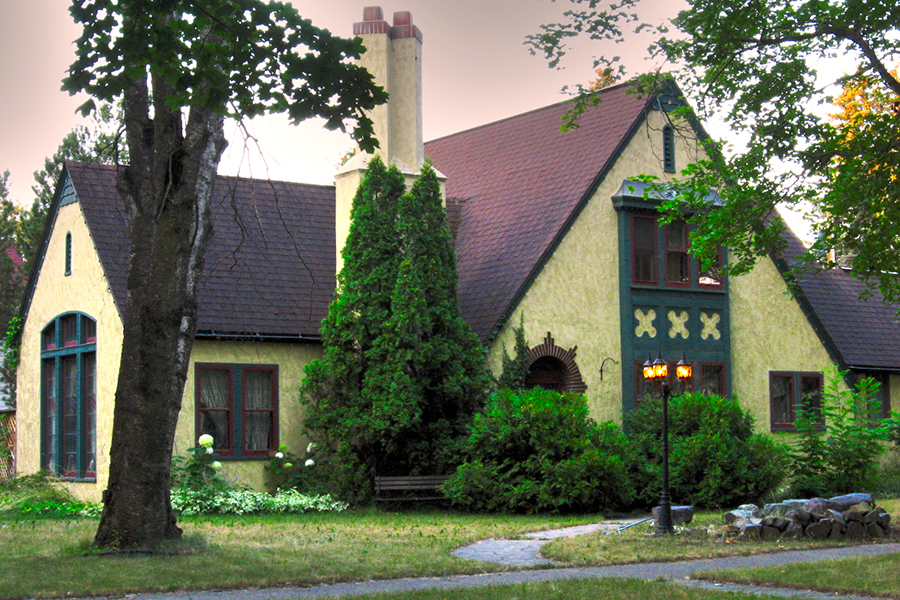There are several influential architects who shaped the architectural landscape of Kalispell and the Flathead Valley, such as Joseph Gibson, Franklin Madison Morgan, Marion B. Riffo and George Shanley.
And in many ways, it seems Fred Adolph Brinkman was destined to be one of Kalispell’s most influential architects as well. For much like the symmetry and parallel lines of his designs, there are many parallels between Brinkman’s life and his architectural work.
Brinkman’s parents were German immigrants. His father Gustave was a cabinet maker and master carpenter – and reckoned to have built the first house in Kalispell. His mother Amalia (née Wagenknecht) helped organize the Ladies’ Aid group of the Trinity Lutheran Church in 1910.
Incidentally, Brinkman later became a member and supporter as well. In 1949, he designed plans for a new parsonage, cloister, and church – the very church where Brinkman’s funeral was held in 1961 (he also designed other churches in Kalispell, including the Bethlehem Lutheran and First Presbyterian).
Further parallels exist. For example, Brinkman was a president of the Kalispell Chamber of Commerce – and also designed many commercial buildings in Kalispell, including several along Main Street, such as the Montgomery Ward Building (333 Main Street) and Wilson’s Cafe (123 Main Street). He also designed commercial buildings elsewhere in Montana, including the Symes Hot Springs Hotel.
Brinkman graduated from Flathead County High School and later served the school board and designed a new high school building and renovated another. He also designed the Linderman School (124 Third Ave. E.) and the Cornelius Hedges School (827 Fourth Ave. E.).
Brinkman was also civic-minded and a longtime member of the Kalispell Kiwanis Club – and he designed the City Water Department, the St. Mary Visitor Center in Glacier National Park, and other public buildings throughout Montana.
Brinkman was a proponent of city planning – and built his own home in a neighborhood that he helped envision and plan.
Similarly, as “architecture imitates life,” appreciating the “Brinkman House” at 700 Third Ave. E. in Kalispell is much like appreciating the very architecture of Kalispell itself, as the house reflects a culmination and combination of Brinkman’s work.
Like many other homes and renovations Brinkman designed, the home is predominantly drawn from the Tudor-Revival style. But simply calling it “a Tudor” overlooks the meticulous details of the Gothic-Revival, Art Moderne and Mission styles, in which Brinkman also worked with ease.
Adapting styles from cottages found about the European countryside, and embracing modern styles are Brinkman trademarks. And the home features other Brinkman signatures, such as using motifs and patterns to thread a sense of unity.
For example, Brinkman incorporated heraldry in the stained-glass windows, which can also be found at the top of the chimney wall, and atop the oriel window (at places that are “looked through” or “looking out”).
And speaking of looking about, it is perhaps best to visit the Brinkman House, then visit other places Brinkman designed – you’ll soon find yourself having more than a few “aha moments.”
Yet despite the resemblances between life and architecture, there is a bit of irony concerning the Brinkman House. While Brinkman designed dozens of homes and buildings in Kalispell that are listed on the National Register of Historic Places, the Brinkman House is not. So be sure to appreciate it with deserving reverence.
Jaix Chaix appreciates history and architecture. Share ideas and facts with him at [email protected] or at facebook.com/flatheadvalleylandmarks. He is teaching another “Historic Homes of Kalispell” course at FVCC this fall, and guiding “cemetery walks” at the Conrad Memorial and Demersville cemeteries.
